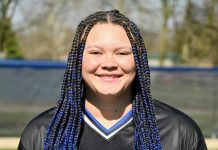Playing a round of golf, particularly 18 holes, takes more time than other sports, but when completing a round takes too much time it’s both frustrating and problematic, players and golf officials said.
Last weekend, Mark Mayhew, a Columbus East junior, was playing with a group of No. 2 golfers in the Hoosier Hills Conference Tournament at St. Annes Golf Course in North Vernon that had fallen two holes behind the No. 1 golfers in front of them. The No. 2 group finished before a rain and lightning delay, but groups behind them had to wait until the rain and lightning stopped to finish their rounds.
Nathaly Munnicha, a freshman on the Columbus North girls team, remembers having to wait more than two hours after her round was finished in the Greensburg Sectional before the rest of the teams were finished.
Last fall, a girls golf sectional at The Legends Golf Club in Franklin took about 6½ hours to complete. Legends general manager Ted Bishop said that was what “tripped the switch” for him to set changes in motion.
[sc:text-divider text-divider-title=”Story continues below gallery” ]
State golf officials are making changes to improve the pace of play in anticipation of similar changes by a national golf association.
Representatives from the Indiana High School Athletic Association, Indiana Golf Association, Indiana High School Golf Coaches Association, Indiana PGA and the United States Golf Association developed an unprecedented junior golf “Pace of Play” action plan that will increase awareness through education with an added element of accountability for junior golfers and their coaches.
The majority of responders in a survey completed by 147 Indiana high school coaches believe that a reasonable pace of play is 4½ hours or less for 18 holes. They identified common causes as:
Players not being ready to play when it’s their turn
Players not moving quickly enough between shots
Pre-shot routines taking too long
“The bottom line is, rounds are taking so long in golf, it’s taking up your whole day,” said Chris Kaufman, the IHSAA assistant commissioner who administers boys and girls golf. “The game just has to be sped up. It’s more enjoyable than standing around waiting.”
Rule changes coming
Officials are anticipating sweeping changes to the USGA Rules of Golf beginning in 2019. Next year, the IHSAA will conduct rules seminars for all of its high school coaches prior to the start of their seasons.
The IHSAA and the Indiana PGA also have developed a pilot program for the boys high school regular season called “Project 215.” Players are expected to complete nine holes in 2 hours, 15 minutes. At certain courses, procedures and guidelines have been put in place to assist and ensure players complete their rounds in the allotted time.
A deterioration in the pace of play has occurred at the junior golf level, particularly in the past 10 or 15 years, Bishop, a past president of the PGA of America, said.
“Those of us who are seriously invested in the game, when the day comes about that they’re adults, if they reflect back on their high school days, and it took five or six hours to play a round of golf, they’re probably not going to want to play,” Bishop said. “We have to do something to try to make a difference here. The thing I’ve been pleased about with the Project 215, with the matches we’ve had at The Legends, we’ve been able to do that.”
The Legends, which also hosted the boys and girls state finals from 2000 through 2014, was one of the courses that utilized Project 215 this spring.
“I have seen a lot of coaches and a lot of rules officials emphasizing that, and I think it has been a little bit faster this year,” said junior Drew Smith, North’s No. 1 golfer. “We’ve probably been getting most of our rounds in four hours to 4 1/2 hours, and last year, it was probably closer to five (hours).”
Beginning with the girls golf season in July, all sectional golfers and their coaches will be required to view a 20-minute “Pace of Play” video. They then will complete the testing components contained in the video, which will focus on:
Golf course awareness
Pre-shot routines
Putting green procedures
Equipment management
“I’m excited for that because I remember in the sectional, we had to wait for a couple of hours for all the other teams to finish,” Munnicha said. “There’s times where it takes five minutes just to hit a shot, which is kind of frustrating because it messes up your flow. Sometimes, the group ahead of you is waiting to hit, and you have to wait on them.”
Causes for slow play
Several factors can contribute to slow play on the golf course. The IHSAA and Project 215 is focusing on four:
Golf course awareness and how to play “ready golf.” This deals with players being ready to hit their next shot when it is their turn.
Pre-shot routines. Limiting practice swings is a key.
Putting green practices and encouraging holing out. When the player whose ball is farthest away from the hole putts first on a green, that player should continue putting until holing out instead of marking their ball and waiting for the other players to putt.
Equipment management. This deals with where players place their clubs when they are on or near a green, in case then need to go back to their golf bag to retrieve a different club.
“The first thing a lot of people will say is, it comes down to ability,” Kaufman said. “I don’t think that’s necessarily true. I think there’s some learned behavior in it, and I think there’s some things that have never been taught. We’re going to educate our golfers. We’re going to give them an instructional video before the season on ways they can speed up their play.”
Kaufman and Bishop also encourage using a double-par maximum for regular-season matches. For example, on a par-4, once a player has taken seven shots, they would take an 8 and go to the next hole.
Bishop said he has been guilty of focusing more on the technical aspects of the game than playing quickly when teaching golfers.
“As a golf professional, I’ve spent far more time talking about swing fundamentals than I have pace of play,” Bishop said. “Pre-shot routines and putting green routines have become way too excessive. Hopefully, this will make a difference.”
Kaufman said the IHSAA hasn’t considered allowing golfers to use electric carts or caddies, and the IGA doesn’t allow carts because of the emphasis on golfers being in good condition. Golfers, however, are allowed to use push- or pull-carts.
Beginning this year, high school coaches are permitted to give advice at any time, and not just between holes, as was previously the case.
Dual matches go faster
Perhaps because of a battle to beat darkness, or possibly because players have to go to school the next day and have homework to do, weeknight matches tend to go much quicker than Saturday tournaments.
“(Slow play) really comes into play in tournaments,” East boys coach Tom LaBarbera said. “In nine-hole matches, we can use the AJGA (American Junior Golf Association) practice of the player that putts first holes out. When we’re playing against North, coach (Doug) Bieker and I use that to help things move along quickly. But in tournaments, we can’t do that.”
LaBarbera said his team is normally one of the fastest teams because Otter Creek, its home course, asks the Olympians to play their practice rounds between 2 hours and 2:10.
“That has forced my team to play at a quicker pace,” LaBarbera said. “That has been ingrained in them, so sometimes when we go to tournaments, it can get frustrating when other teams are taking so long. There’s no enforcing of pace of play in high school golf. Kids can go as slow as they want, and there’s no consequence.”
Smith, Mayhew and Munnicha all said the pace of play is much faster in junior golf than it is at the high school level.
“I try to play as quick as possible,” Mayhew said. “I (play) ready golf all the time. It can definitely get frustrating playing with slow people, but I understand also, each shot can affect your outcome.”
Bieker said speeding up the game is certainly something that has to happen, and that it may come down to penalizing golfers for slow play.
“Kids just don’t walk with any purpose,” Bieker said. “They’re not ready to play when it’s their turn to play. All those things have to happen, and unfortunately, it’s probably going to come to penalizing the kids in order to strongly encourage them to pick up the pace of play.”
Bieker lays part of the blame on professional golfers.
“I personally think until the PGA Tour speeds up their players, they’re going to be hard-pressed (to speed up play), or until they start giving penalties to kids,” Bieker said. “I think until they do it at the highest level, until the Jordan Spieths and the Tiger Woodses lead by example and play faster — and I understand they’re playing for a lot of money — these kids imitate what they watch, so there’s really no encouragement for them to play any faster.”
Jeff Smith, Drew’s father and director of instruction at Timbergate Golf Course in Edinburgh and Sagamore Golf Club in Noblesville, agreed.
The former teaching pro at Otter Creek and one of 12 teachers nationwide on the faculty of instruction for the PGA of America, Jeff Smith said what young golfers see on television happens to influence them.
“They tend to walk slow, and then they tend to prepare for their shot very slowly,” he said. “If they cut down on the preparation time, and they move a little faster between shots, then they can play an awful lot faster.
“But I think it’s truly that they’re not prepared to play the shot when it’s actually their turn because they’re waiting around for somebody else to play their shot, and then they get into their routine, and I think that’s a little bit foolish,” he added. “I think that’s where a lot of the time can be cut out of the rounds of golf.”
[sc:pullout-title pullout-title=”If you go” ][sc:pullout-text-begin]
The boys golf potseason gets underway this week with sectional action at 30 sites. Columbus East, Columbus North and Hauser will play in the Greensburg Sectional beginning at 9 a.m. Friday at Greensburg Country Club.
The top three teams advance to the regional June 7 at Champions Pointe in Henryville. The top three from there move on to the state finals June 12-13 at Prairie View in Carmel.
[sc:pullout-text-end]




